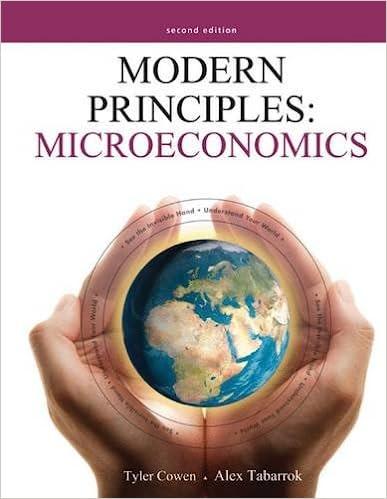1.6. Imagine that two players are competing over a valuable resource. Each player has two options. He...
Question:
1.6. Imagine that two players are competing over a valuable resource. Each player has two options.
He or she can either be aggressive and demand the entire resource, or the player can offer to split the resource equally. The literature uses the word "Hawk" to describe the aggressive behavior, and the word "Dove" to describe the sharing behavior. If two Hawks meet, then both will demand the resource, neither will give in, and there will be a fight. If a Hawk meets a Dove, the Hawk will take the resource and the Dove will get nothing. If two Doves meet, the resource will be shared equally.
Assume that the value of the resource is 60; the cost oflosing a fight is 1 00; and if two Hawks fight, each of them has a 50% chance of losing.
Here's the payoff matrix:
B's Strategies Hawk A's Strategies Hawk Dove Dove
a. Oops! The payoffs are missing. You'll have to fill them in. Remember, if there's a fight, there is a 50% chance of winning 60 but also a 50% of losing the fight, which has a payoff -100. What's the expected outcome? Ifboth animals choose Dove, assume that they peacefully split the re source. If one is a Hawk and the other is the Dove, the Hawk gets the resource, and the Dove receives nothing
b. Explain why (Hawk, Dove) and (Dove, Hawk) are both Nash equilibriums.
c. The Hawk-Dove game is often used to discuss international relations. Can you explain why a country might like to be perceived as a Hawk? What are the dangers ofbeing a Hawk? What are the dangers of being a Dove?
d. Biologists also use game theory to under stand animal behavior, but they interpret the strategies a little differently. Instead of allowing an animal to choose a strategy, they assume that x percent of animals in a popu lation will always play Hawk and 100 - x percent of animals in a population will al ways play Dove, and they also assume that animals will meet randomly.
Biologists argue that if Hawk has an expected higher payoff than Dove, then Hawks will outcompete Doves so that over time, evolution will increase the percentage of animals playing Hawk. Similarly, ifDove has a higher payoff, then over time, evolution will increase the percentage of animals playing Dove.
Can you find a strategy that is evolutionarily stable; that is, can you find a strategy where the percentage of animals playing Hawk and Dove is stable over time?
Here are two hints: Let x be the percentage of animals playing Hawk. If 0% percent of animals play Hawk (x = 0%) and thus all play Dove, is that evolutionarily stable? If all animals play Hawk (x = 100%), is that evolutionarily stable?
Step by Step Answer:

Modern Principles Microeconomics
ISBN: 9781429239998
2nd Edition
Authors: Tyler Cowen, Alex Tabarrok






